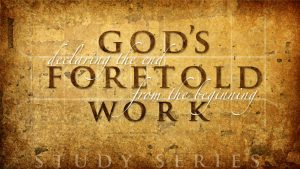Does our view see the Day of the Lord as one specific, single day occurring at the end of the tribulation when Christ returns to destroy the AC and raise the righteous dead? I’ve heard we need to include the broad concept of the day of the Lord, meaning, that the Day of the LORD (DOL) begins with the abomination and continues for three and one half years.
Is this legitimate and correct?, or should the DOL be confined to one single extraordinary day occurring at the end of the tribulation thereby ushering in the first day of the millennial age? For example, is Ezekiel 39:8 a single day or a period of time in duration?
“Doc”
I believe it is the latter choice. It is a very specific day (“one day”; Isa 66:9; Zech 3:9; 14:7), around which is clustered an intensive convergence of many events, leading to, and issuing from, that are certainly not confined to one day. It is the day and hour, even instant (1Cor 15:52) that constitutes the great transition between this age and the age to come.
To answer your last question first, most definitely and assuredly Eze 39:8 is the “great day of God Almighty“ referred to in Rev 16:12-17. This is seen very clearly by observing that the same, very precise language of Eze 39:8 is applied to the “great day of God Almighty” in Rev 16:17.
Significantly, this day is shown to come in conjunction with the 7th bowl, which significantly follows Jesus’ announcement that His now truly imminent coming will be “like a thief” (Rev 16:15). This announcement is significantly interjected between the 6th and 7th bowls. So the time in view here is very precisely the very end of the tribulation.
Note too that in all of scripture, the only two places that the precise term, “day of God” is found is in 2Pet 3:12 and Rev 16:14. In second Peter, the “day of God” is a synonym for the thief-like day of the Lord (2Pet 3:10, 12). These are important markers, since in both 2Pet 3:10-12 and Rev 16:12-17, the “day of God” comes as a thief on the unsuspecting world of unbelievers at the very end of the tribulation.
From this you can see that the DOL and the great day of God Almighty are the same day, and the latter is clearly at the 7th bowl. The DOL doesn’t get any narrower than that, and this is the usual meaning throughout the prophets.
However, there are 3 possible (?) exceptions to this rule. As far as I’m aware, there are exactly 3 places where the DOL appears to comprehend all of the the last half of Daniel’s 70th week. These are Joel 2:1-3; Jer 30:7; 1Thes 5:3.
Jer 30:7 uses the term “that day”, but does this mean the whole 3 1/2 years of Zion’s travail is “that day”? or is this language intended to signify that the onset birth pangs brings on that day?
The same could be said of Joel 2:1-3. There we see the Land as a scene of Edenic verdant beauty when suddenly invaded by the northern army, likened to an army of devouring locust that turns the Land to a blackened desolation.
We know the Land is not Edenic at the end of the tribulation but at the start. So does the invasion start the DOL or does it end in the DOL?
A number of scriptures in the prophets, including Joel, place the DOL as “near” or “at hand”, not at the outset of the tribulation but at its end, when the armies of the earth are gathered, even after the stellar darkness that takes place “immediately AFTER the tribulation of those days” (Isa 13:10-11; 34:4; Joel 2:2, 31; 3:15; Zeph 1:15; Mt 24:29; Acts 2:20; Rev 6:12).
So if the DOL is AFTER this darkening of the sun and moon (Mt 24:29; Acts 2:20) And if the darkness is AFTER the tribulation, then the DOL / great day of God Almighty is a very specific time AFTER the darkness that AFTER “the tribulation of those days”, i.e., the end of the end.
Multitudes, multitudes in the valley of decision: for the day of the LORD is NEAR in the valley of decision. Joel 3:14
Here the armies have gathered for Armageddon at the end of the tribulation, but the DOL is not yet. Here is a rhyme that underscores the point. “If anything should be CLEAR, it is that when something is NEAR, it is not yet HERE!” ?
This suggests that mention of the things that start the final 3 1/2 years are not the DOL precisely, but are the events that trigger it and terminate with it.
The same can be said of the final example in 1Thes 5:3.
For when they shall say, Peace and safety; then sudden destruction cometh upon them, as travail upon a woman with child; and they shall not escape.
Although the DOL comes as a thief, it is never represented as imminent or independent of preceding signs. For example, in 2Thes 2:1-3 “that day” must be preceded by the falling away and the revelation of the man of lawlessness. So here, in 1Thes 5:3, the day cannot arrive unless it is first preceded by a recognizable declaration (presumption) of “peace and safety”. This is yet another sign that must precede the DOL.
Certainly, this is not the end of the tribulation, since the last moments of the history of this age ends in anything BUT peace and safety. So what is this declaration and when is it?
The most likely background for what Paul is anticipating here is found Eze 38:8, 11, 14; 39:26 (also Isa 28:15, 18). There the attack of the final agressor of whom, not only Ezekiel, but “ALL” the prophets have spoken (Eze 38:17) finds the covenant people under the delusion of presumed safety. That this is not abiding millennial security but pre-tribulational false security is shown by observing that this invasion that ends with Israel’s national regeneration (Eze 39:21-29).
So here you have the DOL coming upon a recently regathered nation that is dwelling in a fragile, false security (Eze 38:8, 11, 14; Eze 39:26). Since we know this security does not exist after the tribulation begins, the question comes: Is this sudden disruption of Israel’s peace the arrival / beginning of the DOL? (i.e., a broader period, inclusive of the entirety of the 3 1/2 years). Or, is this invasion simply the event that brings on the DOL 3 1/2 years later?
In view of the above evidence that so well defines the DOL and places it (in the far greater number of references) at the very end of the tribulation, I am inclined to favor the latter. Moreover, every error that I know that places the rapture before the end, whether pre-trib, mid-trib, or pre-wrath, all depend on moving the DOL around to different starting points in order to extend the DOL to include all, or some significant portion of Daniel’s 70th week
(note that only the last half of 70th week should be seen as the “great tribulation”, because until the abomination is placed in the middle of the seven, Israel is under the illusion that peace has come).
For example, pre-tribulations can only be maintained by making the DOL include the entirety of the 70th week. Just why their system stands or falls with this ‘assumption’ is a discussion too tedious and involved to embark upon here, but it’s a study in how the defense of one inference, not explicitly stated in scripture, requires the defense of another inference, also not explicitly stated in scripture.
Hope that helps, Reggie





